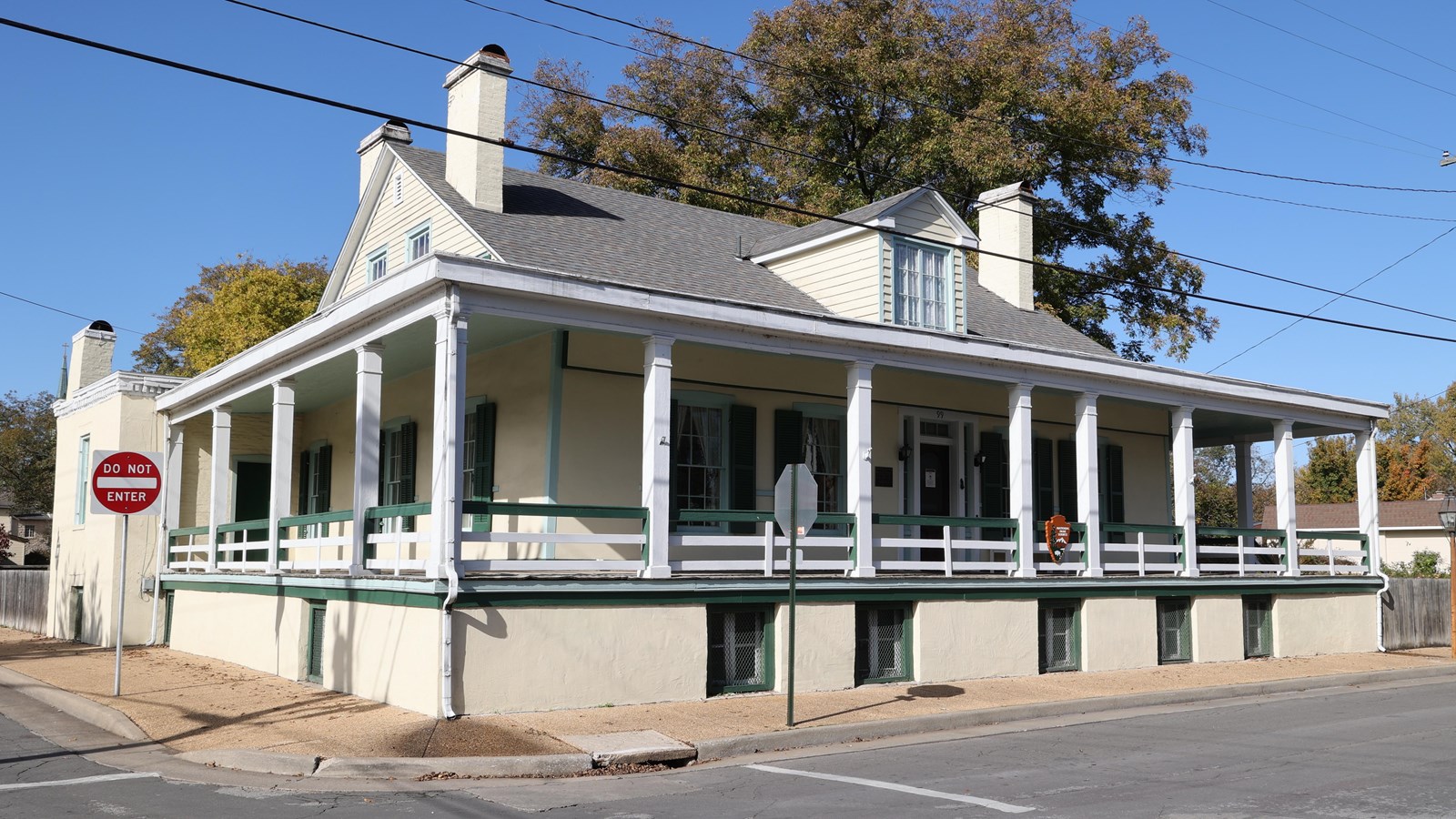Last updated: July 14, 2024
Place
Jean Baptiste Vallé House

NPS
Benches/Seating, Cellular Signal, Fire Extinguisher, First Aid Kit Available, Historical/Interpretive Information/Exhibits, Junior Ranger Activity
From its construction in 1794 until 2010, the Jean Baptiste Vallé House served as a private residence for numerous families. The house and its residents underwent many changes as they adapted to ongoing social and political shifts surrounding the community.
Architecture
The Jean Baptiste Vallé House’s appearance changed drastically over the 216 years that it
served as a home. The house started its life as a traditional French colonial vertical log structure with a wrap-around porch. As a poteaux-sur-sole house, the vertical timbers rest on a stone foundation.
Today, the colonial vestiges of the Jean Baptiste Vallé House are hidden away behind the modern plaster. Though the vertical logs still form the framing of the building, brick additions and a new roof have further changed its outward appearance.
The Home’s First Residents
The house was built for the Vallé family. Jean Baptiste and Marie Jeanne Vallé both came from prominent families of the Illinois Country. They became wealthy citizens through numerous investments in agriculture, trading, and mining.
Much of the Vallé family wealth was gained through the work of enslaved people who were forced to work in agricultural fields, mines, and households. At least twenty-nine people were enslaved by Jean Baptiste and Marie Jeanne at this home including Marie and her son Joseph Philibert, Samson, Madelaine, Michel, twins Joe and Peter and their mom Félicité, among others. The people that were enslaved lived separately on the property and would have done the labor related to managing the household. The National Park Service is still researching the individuals who were enslaved at this home, details about their lives, and their connections to other individuals in Ste. Genevieve.
The Garden
French colonial town lots were usually surrounded by a palisaded cedar fence. This kept free roaming livestock out of the gardens. Each lot would often feature several outbuildings, such as housing for enslaved people, barns, and a kitchen. Kitchen gardens and orchards were common as well. The people of Ste. Genevieve relied on their gardens for much of their food.
The Jean Baptiste Vallé House had another garden, a rose garden. Formal rose gardens were a way to show wealth in France. Madame Chouteau, a prominent woman from St. Louis, sent Marie Jeanne some rose cuttings and encouraged her to plant a rose garden. Marie Jeanne would further develop her garden by ordering roses from France. Today’s garden has been redeveloped in the spirit of Marie Jeanne’s.
Later Residents
The Vallé family remained residents of the home until Jean Baptiste Vallé died in 1849. The property then passed to his granddaughter Mary Louise and her husband Anthony LaGrave. Anthony took ownership of the home when the community of Ste. Genevieve was experiencing a cultural shift. An influx of diverse migrants moving west as the United States expanded brought with them changing tastes, including tastes that influenced the colonial homes. Adapting to the cultural influences of the United States, Anthony had the home renovated from its traditional French colonial design to a Georgian style house.
The 1860s renovation included both structural and social changes. Anthony changed the layout of the lower level and added stairs to access the newly developed second story. The additional rooms reflected a growing interest in separating private and public spaces. During the French Colonial period, residents did not emphasize this separation of space or the same concept of privacy.
The renovation process lasted throughout most of Anthony LaGrave’s ownership of the
home. In 1870, the LaGraves sold the home to the final private residents, the Vion-Papin-Schram family. The Vion-Papin-Schram family lived in the home until 2010.
The Louisiana Purchase
In 1804, the Louisiana Purchase was being finalized, making Ste. Genevieve and the rest of the Louisiana Territory a part of the United States. The residents of Ste. Genevieve experienced a cultural, political, and legal shift under the United States government. One major change was the transition from a legal system based in civil law to one based in English common law.
French customary law had allowed women like Marie Jeanne to own and control their own property and enter contracts in their own names. In contrast, her granddaughter Mary Louise’s property rights were restricted and a question of Missouri state law. Women in Ste. Genevieve adapted to these changes and continued to be active participants in churches, schools, courts, and businesses.
The men, women, and children who were enslaved at this home still were not considered citizens. Because lawmakers feared slave revolts like those of the successful Haitian Revolution, the individuals enslaved here and across the United States were forced to abide by additional laws further restricting their gatherings and movements. Starting in 1835, individuals who gained their freedom had to obtain a license to prove they were free. Legal enslavement would continue in Missouri until January 1865.
Jean Baptiste Vallé had become the civil and military leader of Ste. Genevieve following in his brother’s and father’s footsteps. After the Louisiana Purchase, Jean Baptiste maintained control of the community for six months, after which he became Justice of the Peace. Though laws and titles changed, the Vallé family and other wealthy members of the community still maintained power in the U.S. system.
